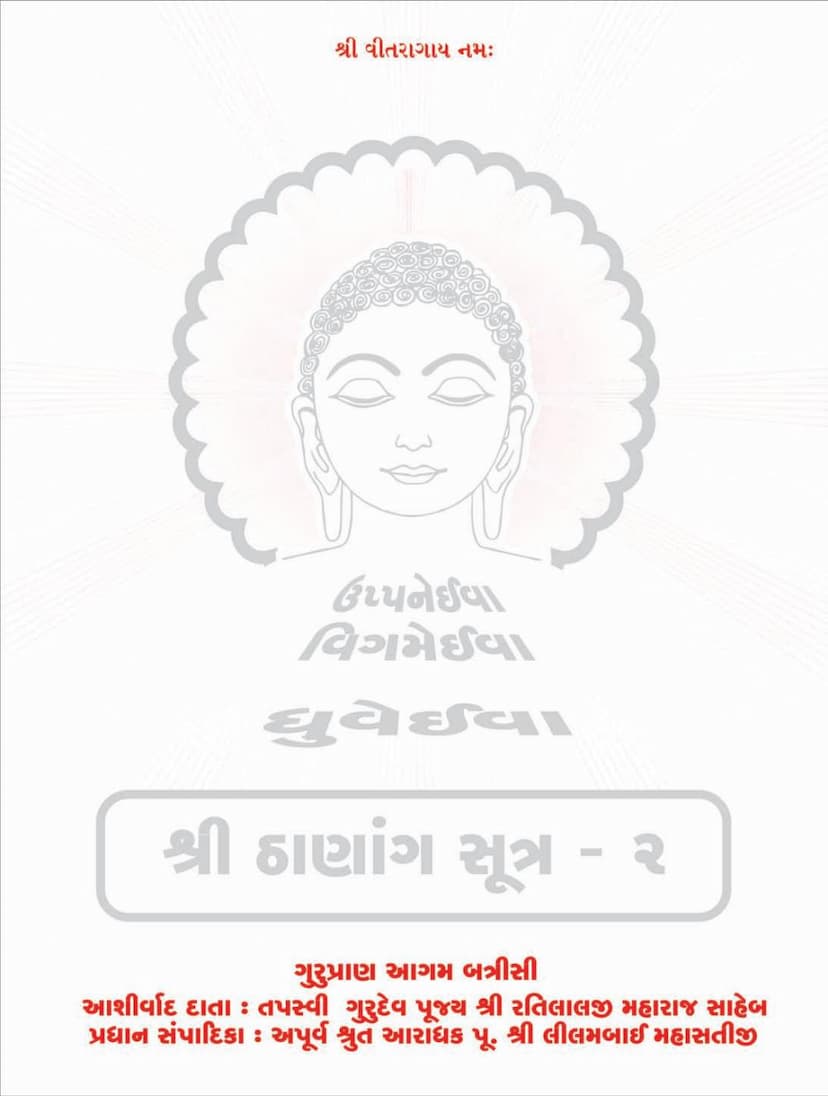Agam 03 Ang 03 Sthanang Sutra Part 02 Sthanakvasi
Added to library: September 1, 2025

Summary
This is a comprehensive summary of the Jain text "Agam 03 Ang 03 Sthanang Sutra Part 02 Sthanakvasi," authored by Virmatibai Mahasati, Artibai Mahasati, and Subodhikabai Mahasati, and published by Guru Pran Prakashan Mumbai. The text is a part of the "Guru Pran Agam Batrisi" series.
Overall Scope and Significance:
The book is the second part of the third Anga (Sthanang Sutra) of the Jain Agamas, specifically focusing on the "Sthanang Sutra." It is presented as part of the "Guru Pran Agam Batrisi," a series dedicated to publishing Jain scriptures. The publication is a revival and re-printing of important Jain texts, aiming to spread the teachings of Lord Mahavir. The text is deeply rooted in the tradition of the Gondal Gachha and is dedicated to the memory of esteemed Gurus like Shri Dungarsinhji M.S., Shri Pranalalji M.S., and Shri Ratilalji M.S.
Key Themes and Content:
The Sthanang Sutra, as presented in this volume, is described as a vast and diverse scripture, containing millions of "thanas" or points. It is likened to a vast banyan tree with innumerable leaves, each leaf representing a point of knowledge. The text covers a wide spectrum of Jain philosophy, ethics, cosmology, and practices, organized numerically.
Specific Areas Covered (as evidenced by the Table of Contents and introductory remarks):
The table of contents reveals the incredibly detailed and systematic nature of the Sthanang Sutra. It enumerates items, concepts, and beings based on the number of "thanas" or points they represent, ranging from one to ten, and even beyond. Some of the prominent topics include:
- Basic Principles: Mahavratas (Great Vows), Anuvratas (Minor Vows), Abstinence from sensory pleasures, Causes of bad and good destinies.
- Cosmology and Geography: Descriptions of various realms, planets, rivers, mountains (e.g., Jambudvipa, Patal-kalash, Meru mountains, river systems), celestial beings (Indras, armies, commanders, council of gods).
- Jain Philosophy and Concepts: Asta-dravyas (Eight substances), Knowledge types (Kshaya-shobhik, Kshaya), Types of karma, Causes of karma bondage and cessation, Auspicious and inauspicious signs, Nivratta (abstinence) and Anuvratta (minor vows), Lifespans and characteristics of various beings (Nairayikadi), Types of bodies, Knowledge states (Kevali, Chhadmastha), Naya (viewpoints), Loka-sthiti (state of the universe), Karma Bandha (karma bondage), Types of Loya (lok).
- Ethics and Conduct: Rules for ascetics (Sadhus and Sadhvis), Various types of vows, Austerities (Tapas), Obeisances (Vandana), Principles of non-violence (Ahimsa), Truthfulness, Non-stealing, Celibacy, Non-possession, Principles of good conduct and behavior.
- Practices and Rituals: Rules related to dietary restrictions, Specific vows (Abhigraha), Practices related to sitting postures (asana), Religious observances, Rules for the conduct of ascetics and nuns, Rules for undertaking religious retreats (Varshavas).
- Historical and Biographical Information: Biographies of key figures like Guru Shri Dungarsinhji M.S., Guru Shri Pranalalji M.S., Guru Shri Ratilalji M.S., and mentions of various Acharyas and Mahasatijis involved in the publication.
- Specific Topics: Causes for the separation of a community (Gachha Sangathan-Vighatan), Types of Pratyakhyana (Renunciation), Types of Pratikramana (Confession), Details about celestial beings (Devas), their lineage, celestial vehicles, and lifespans, Causes of mental states like Unmad (madness), Rules of conduct for ascetics and nuns, details about various types of tirthankaras and their lifespans.
- Specific Numerical Categorizations: The text meticulously categorizes a vast array of phenomena, principles, beings, and concepts based on numbers, particularly focusing on the number ten and other significant numbers. This includes ten types of karma, ten types of knowledge, ten types of conduct, ten types of vows, ten types of hellish realms, ten types of celestial abodes, ten types of spiritual practices, ten types of spiritual progress, ten types of consequences of actions, ten types of faults, ten types of virtues, and much more.
Purpose and Vision:
The publication is driven by a vision to spread Jainism and its eternal truths to the masses. It emphasizes the importance of studying the Agamas, understanding their core principles, and living a life of Panchachar (five types of conduct). The effort is a tribute to the gurus and a way to perpetuate their legacy and the teachings of Jainism. The "Guru Pran Prakashan" and the dedicated team of Mahasatijis have undertaken this significant task with great devotion and scholarly rigor.
The Role of Gurus and Mahasatijis:
The book highlights the contributions of several revered Mahasatijis and Munis, including:
- Chief Editor: Poojya Shri Lilambai M.
- Translators: Poojya Shri Veermati Bai M., Poojya Shri Lilambai M.
- Co-Editors: Dr. Sadhvi Shri Aarti Bai M., Poojya Shri Subodhika Bai M.
- Advisors and Inspirers: Poojya Shri Jayant Muni M.S., Poojya Shri Girish Muni M.S., Poojya Shri Janak Muni M.S., Poojya Shri Hasumukh Muni M.S., Poojya Shri Namra Muni M.S.
- Foundational Gurus: The entire "Guru Pran Agam Batrisi" series is inspired by the legacy of Pujya Shri Pranalalji M.S. and Pujya Shri Ratilalji M.S.
The Sthanang Sutra's Importance:
The Sthanang Sutra is considered a foundational text due to its systematic classification of Jain knowledge. Its unique numerical approach helps in understanding the vastness and interconnectedness of Jain teachings. The text serves as a guide for both spiritual and practical aspects of life, touching upon topics relevant to the spiritual seeker as well as the layperson.
Overall Impression:
This book represents a monumental effort in preserving and disseminating Jain Agamic literature. The dedication of the authors, editors, publishers, and the entire "Guru Pran Prakashan" team is evident, making this a valuable resource for anyone seeking to understand the depth and breadth of Jain philosophy as elaborated in the Sthanang Sutra. The text aims to bring the timeless wisdom of the Agamas to a wider audience, enabling personal spiritual growth and the propagation of Jain dharma.